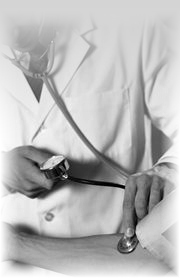 Medical Services
Medical Services
Echocardiogram
You have been recommended to have an Echocardiogram and I would like you to read this information sheet, prior to your scheduled test in our office. This test is also known as an Echo, 2D echo, cardiac ultrasound, and echocardiography.
What is an Echocardiogram?
An echocardiogram (often called "echo") is a graphic outline of the heart's movement. During an echocardiogram test, ultrasound ( high-frequency sound waves) that come from a hand-held wand placed on your chest, is used to provide pictures of the heart's valves and chambers and help the sonographer evaluate the pumping action of the heart. Echo is often combined with Doppler ultrasound and color Doppler to evaluate blood flow across the heart's valves.
Why is an Echocardiogram Done?
Your doctor uses the echocardiogram to:
- Assess the heart's function.
- Determine the presence of disease of the heart muscle, valves and pericardium, heart tumors, and congenital heart disease.
- Evaluate the effectiveness of medical or surgical treatments.
- Follow the progress of valve disease.
What Preparation is Needed?
- You can wear whatever you like. You may be given a disposable paper gown to wear during the procedure.
- You may eat and drink as you normally would on the day of the test.
- Take all of your medications at the usual times, as prescribed by your doctor.
What Can be Expected?
- Before the test, a cardiac sonographer (an allied health professional who has been trained specifically to perform ultrasound examinations), will explain the procedure in detail, including possible complications and side effects.
- You may be given a disposable paper gown to wear as you will be asked to remove your clothing from the waist up.
- A cardiac sonographer will place three electrodes (small, flat, sticky patches) on your chest. The electrodes are attached to an electrocardiograph monitor (ECG) that charts your heart's electrical activity.
- The sonographer will ask you to lie on your left side on an exam table.
- The sonographer will place a wand (called a sound-wave transducer) on several areas of your chest. The wand will have a small amount of cool gel on the end, which will not harm your skin. This gel helps get clearer pictures.
- Sounds are part of the Doppler signal. You may or may not hear the sounds during the test.
- You may be asked to change positions during the exam in order to take pictures of different areas of your heart.
- You may be asked to hold your breath at times.
- You should feel no major discomfort during the test. You may feel coolness from the gel on the transducer and a slight pressure of the transducer on your chest.
- The echo test takes about 40 minutes. After the test, you may get dressed and go home or go to your other scheduled appointments.
- Before you leave the office, please schedule a follow up appointment to discuss the results of your test.
Appointment Cancellations:
This time has been especially set aside for your test so please give us at least 24 hour notice if you are unable to keep your appointment, as a $25 cancellation penalty will be charged for any missed appointments cancelled the same day of the test.
Prime Healthcare Providers is not responsible for the content of any linked site. See our Terms and Conditions.

